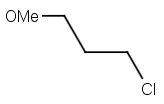Alias to Group
This action converts set pseudo and alias atoms to default S-groups. (aliastogroup)
Example:
|
Action |
Input |
Output |
|
Alias to Group |
|
|
Note:
-
The input molecule contains two aliases; "OMe" and "Cl". Action "Alias to Group" recognizes alias "OMe" as an element of the existing default abbreviated groups (methoxy group) and converts it to methoxy group.
-
The converted group is always contracted.
The action uses ChemAxon's default abbreviated groups dictionary.
The list of alias and pseudo atoms can be customized by extending the built-in abbreviated groups dictionary .
Advanced usage example:
Additional abbreviated groups can be specified in a file called user.abbrevgroup. This file should contain the following elements in a TAB-delimited text format:
-
abbreviation of the group
-
CXSMILES string representation of the group
-
attachment atom number
For example, a tosylate group can be defined as follows:
Ts OS(=O)(=O)C1=CC=C(C)C=C1 1
The created file has to be placed in the chemaxon settings directory that is situated in the chemaxon or .chemaxon folder inside the home directory of the user.
There is no difference between the input and the output structures of the Alias to Group action, however, the two Ts groups are represented differently.

In case of the input structure, the Ts group is simply placed on a methyl functional group as a label.
However, in the output structure it is already recognized as a structural moiety. This can be investigated by applying another action for the output structure, Expand S-groups.
This action recognizes the Ts abbreviation and expands it into its correct chemical form.

